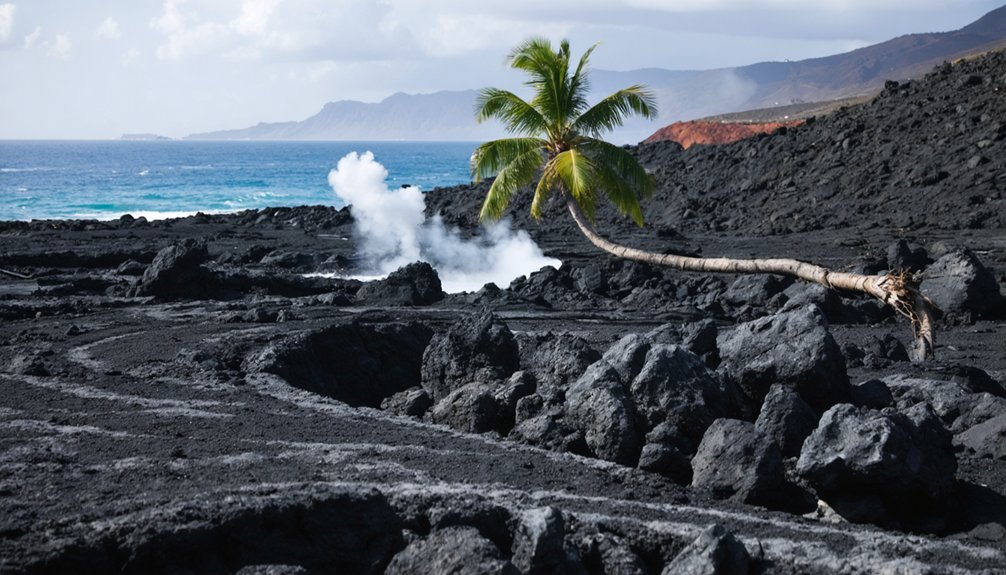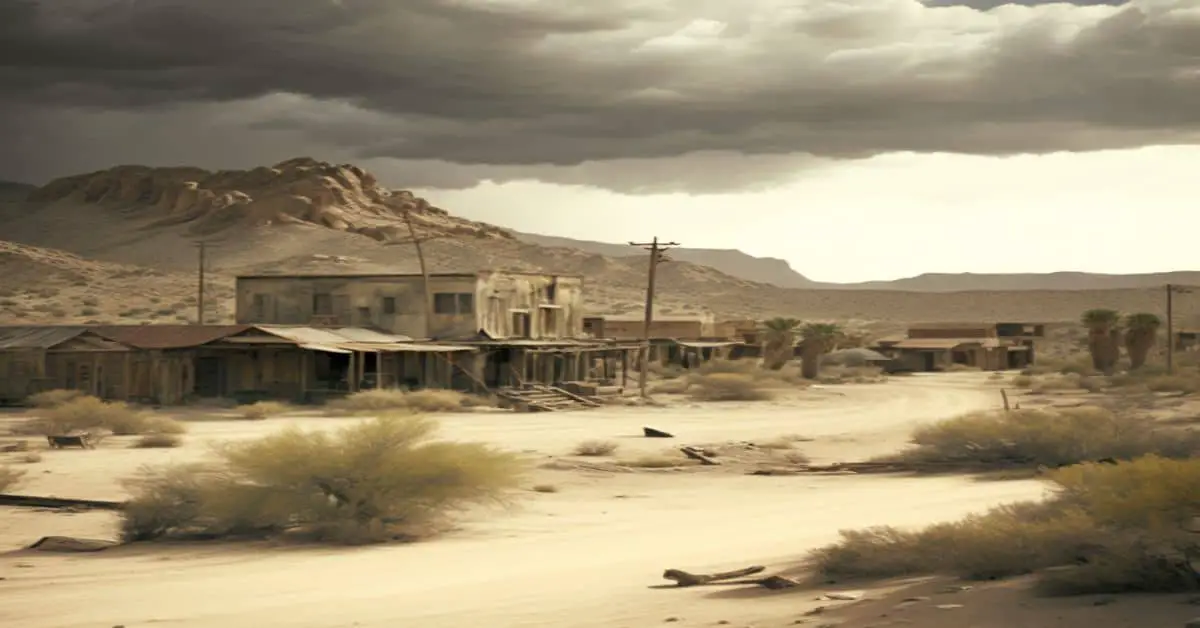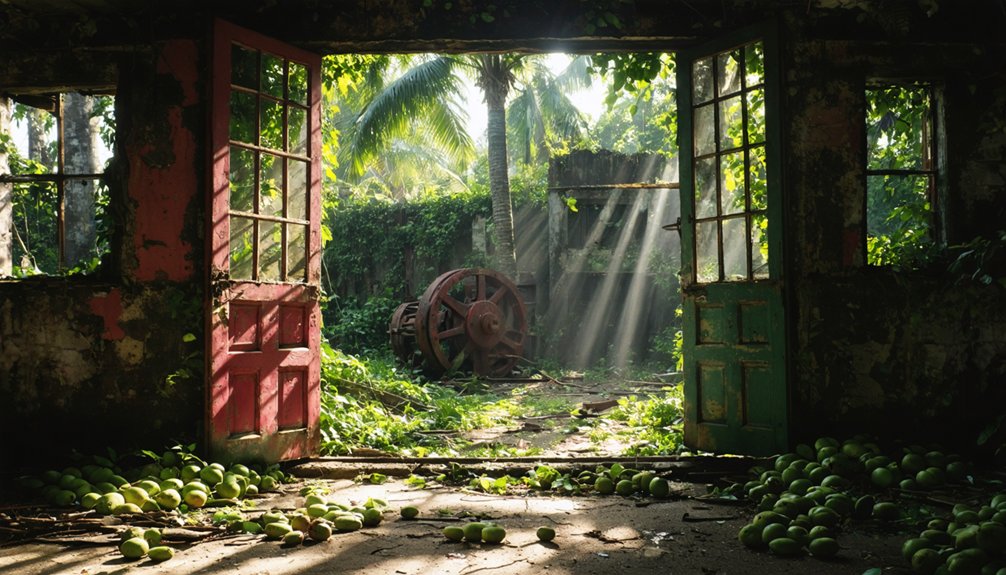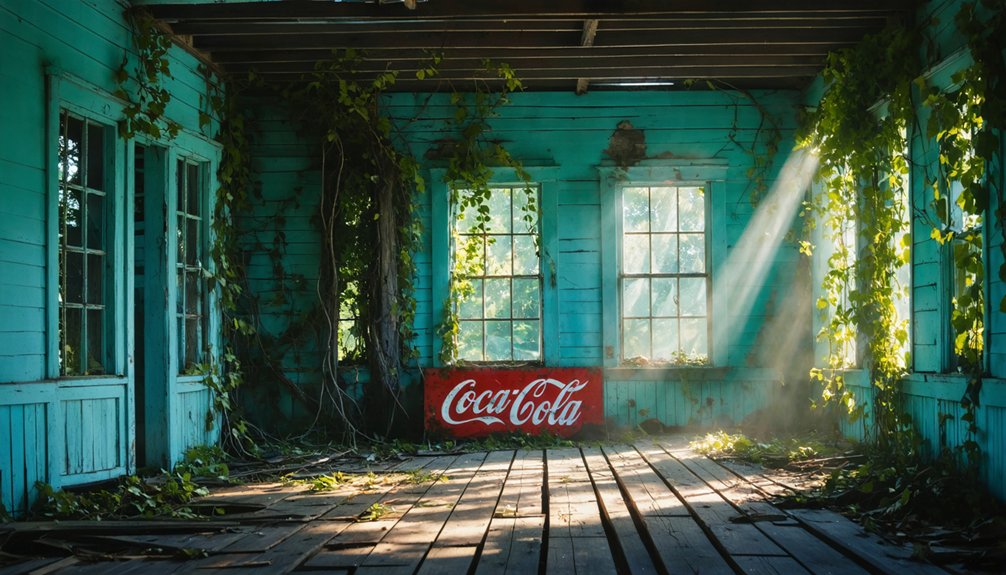You’ll find the haunting remains of Kalapana, a once-thriving Hawaiian fishing village, transformed by Kilauea’s Pu’u ‘Ō’ō eruption that began in 1983. The lava flows buried 215 homes, the legendary Kaimu Black Sand Beach, and centuries of cultural heritage. Today, a few resilient residents live off-grid among the volcanic terrain, while a new black sand beach has emerged from nature’s fury. The story of Kalapana’s transformation reveals profound lessons about loss, rebirth, and ancestral connections.
Key Takeaways
- Kalapana transformed from a thriving Hawaiian fishing village into a ghost town when the Pu’u ‘Ō’ō eruption buried 215 homes under lava flows.
- The 1990 volcanic eruption destroyed most of the original town, including the historic Kaimu Black Sand Beach and surrounding neighborhoods.
- Only a few residents remain in modern Kalapana, living off-grid while maintaining cultural connections to their ancestral lands.
- The Star of the Sea Painted Church was saved from destruction by being relocated five miles away, preserving an important cultural landmark.
- A new black sand beach has formed from cooled lava, attracting tourists and symbolizing nature’s renewal in this ghost town’s landscape.
The Volcanic Devastation That Changed Everything
When the Pu’u ‘Ō’ō eruption began in January 1983, no one could have predicted its devastating 35-year reign over Kalapana’s landscape.
You’d witness nature’s raw power as extensive lava tubes fed molten rivers up to 12 kilometers downslope, forever transforming this sacred place.
The volcanic hazards proved relentless. Lava flows engulfed 215 homes in Kalapana Gardens and Royal Gardens, burying cherished black sand beaches and severing crucial access routes. Recent volcanic activity shows this destructive force continues, with lava fountains reaching up to 700 feet at Halemaumau crater in 2025.
Lava’s unrelenting march devoured hundreds of homes, sacred beaches, and vital roads, leaving Kalapana forever altered beneath its molten grip.
The continuous assault reshaped 13.7 square miles of land, creating 875 acres of new coastline while destroying generations of community connections. This long-running eruption was just one chapter in Kilauea’s history, as the volcano has been intermittently active for at least 2,000 years.
Yet through this destruction, you’ll find stories of community resilience.
Like the land itself, Kalapana’s spirit endures – a reflection of the profound relationship between people and place in Hawaii’s volcanic landscape.
Life Before the Lava: A Paradise Lost
Paradise embraced Kalapana’s southeastern shores before the devastating lava flows, where generations of Native Hawaiian families lived in harmony with the land and sea.
You’d find a thriving community practicing traditional agriculture in the fertile volcanic soil, cultivating crops from the mountains to the coast. Along the rugged shoreline, fishermen sustained their families from the abundant marine life, while dense ʻōhiʻa forests provided resources for cultural practices. Tragically, by mid-July 1990, lava overran homes and forever changed this cherished landscape.
The 1975 magnitude 7.7 earthquake dramatically impacted the region, marking the beginning of significant geological changes for the community. The community’s resilience showed in their deep connection to the ahupuaʻa system, managing resources from mauka to makai. Schools, parks, and gathering places dotted the landscape, knitting together a close-knit population that preserved ancient sites and customs.
This was Kalapana – a living embodiment of Hawaiian culture and sustainable living.
Relocating a Community: The Birth of Kikala-Keokea
As lava consumed the original Kalapana community, the Hawaii State Legislature established Kikala-Keokea in 1991 to preserve the cultural legacy of displaced Native Hawaiian families. Through Act 314, you’ll find 67 one-acre lots offered under 65-year leases, specifically designed to help maintain traditional practices like fishing, farming, and gathering medicines.
Despite the community’s resilience, initial resettlement proved challenging. The state invested $4.6 million to develop the subdivision. While the first lots were issued in 1995, it took 11 years before the first resident moved in. The families maintain their ho’oponopono healing practices alongside Christian beliefs.
The path to rebuilding wasn’t easy – a full decade passed between lot distribution and the first family making Kikala-Keokea home.
Today, you’ll see signs of cultural continuity taking root as younger generations build homes and revive ancestral traditions. They’re crafting konane, building canoes, and protecting marine resources.
Though only 15 lots are currently occupied, the growing settlement represents hope for preserving Hawaiian ways of life near their original homeland.
Sacred Sites and Cultural Heritage
Beyond the physical relocation of families, Kalapana’s deep spiritual significance anchors its people to their ancestral lands. The sacred landscapes here tell stories of cultural resilience, where Pele’s presence shapes both the physical and spiritual domain. Located in the Puna District of Hawaii’s Big Island, this area continues to draw visitors seeking connection to Hawaiian heritage.
- The Star of the Sea Painted Church stands as a tribute to faith and artistic heritage.
- Ancient heiau sites preserve connections to traditional Hawaiian religious practices.
- Black sand beaches serve as natural temples, bridging past and present.
- Local families maintain access rights and lead cultural tours, keeping traditions alive.
- Community gatherings and night markets breathe new life into lava-transformed lands.
Over 180 homes were destroyed when the Kilauea volcano erupted in 1990, yet this catastrophic event strengthened the community’s spiritual bonds. You’ll find that despite volcanic destruction, Kalapana’s spirit endures through its people, who continue to honor Pele while preserving their cultural heritage through storytelling, replanting, and maintaining sacred connections to this wahi pana.
Nature’s Rebirth: The New Black Sand Beach
When Kilauea’s molten fury buried the original Kaimu Black Sand Beach in 1990, it transformed a cherished fishing village into a stark moonscape of fresh lava.
Today, you’ll witness an extraordinary volcanic transformation as ocean waves gradually break down the rock into new black sand, creating a beach that’s less than 34 years old.
Witness nature’s raw artistry as relentless waves sculpt volcanic rock into a pristine black sand beach, born from Kilauea’s fury.
Nature’s resilience shines through the barren landscape, where ecological succession unfolds before your eyes. The beach’s hazardous surf conditions make swimming unsafe.
Local residents have planted hundreds of coconut trees, honoring the sacred grove that once stood here. The Star of the Sea Church was safely relocated before lava consumed the area.
Pioneer species of birds and insects now return to colonize this evolving terrain.
You can explore this raw beauty via a quarter-mile trail across the lava field, where each step reveals the powerful story of destruction and rebirth that defines Hawaii’s living landscape.
Surviving Off-Grid in Modern Times
While nature reclaims the volcanic landscape, a determined community thrives in modern Kalapana through innovative off-grid living.
You’ll find resilient residents embracing sustainable practices that blend traditional wisdom with modern technology. Energy independence comes through solar arrays backed by generators, while water conservation relies on sophisticated rainwater catchment systems.
- You can establish food production through year-round gardening in rich volcanic soil
- You’ll harness renewable resources with customized solar power systems
- You’re able to connect globally via Starlink while living remotely
- You’ll join a community that values eco-friendly solutions
- You can build self-sufficiency through local farming and food forests
Living off-grid in Kalapana isn’t just about survival – it’s about creating a sustainable future that honors both the land and your independence.
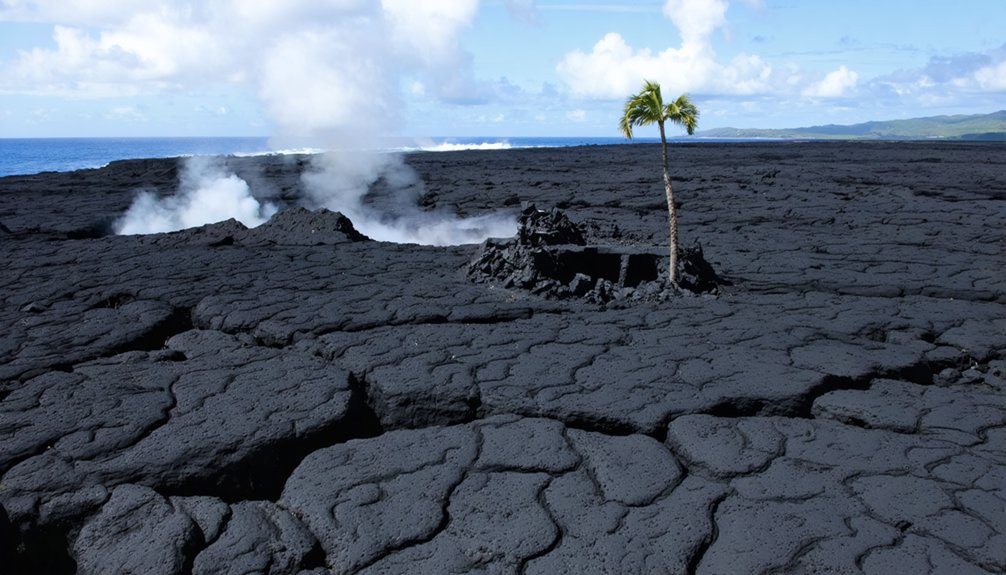
How can you safely witness nature’s raw power at Kalapana’s lava fields? You’ll need to journey 4.5 miles on uneven terrain, either by foot or bike, from Highway 130’s end to reach active flows.
Proper trail preparation is essential: wear sturdy closed-toe shoes, pack water, and bring layered clothing for changing weather.
Pack smart for volcano trails: sturdy shoes protect your feet, water keeps you hydrated, and layers adapt to shifting conditions.
For ideal lava safety, time your visit around sunset when the molten rock’s glow is most visible. You’ll need reliable flashlights or headlamps for the return journey through darkness.
Consider joining cultural tours led by local residents who’ll share their deep connection to this sacred landscape while guiding you safely across the volcanic terrain.
Always respect marked boundaries, avoid toxic fumes, and stay alert for hidden cracks in the lava field’s ever-changing surface.
Preserving History: The Star of the Sea Painted Church
You’ll find the Star of the Sea Painted Church standing proudly in its new location, a representation of the determination of local residents who rescued this sacred structure from advancing lava flows in 1990.
Inside, Father Gielen’s masterful folk art paintings still adorn the walls and ceiling, telling biblical stories through a unique blend of Hawaiian and Catholic perspectives.
The church’s survival serves as a powerful symbol of preservation, where both the physical building and its irreplaceable religious artwork continue to inspire visitors from around the world.
Church’s Daring Rescue Mission
When lava from Kīlauea’s Pu’u ‘Ō’ō vent threatened Kalapana in 1990, the Star of the Sea Painted Church stood directly in its destructive path.
In a remarkable display of community resilience, local residents and parishioners united to save this treasured piece of Hawaiian cultural heritage.
- Entire 22×36-foot wooden church strapped to a flatbed trailer
- Moved less than five miles to safety on Highway 130
- Rescued just before lava consumed the original site
- Funded and executed entirely by community effort
- Preserved one of Hawaii’s only two surviving painted churches
The daring rescue preserved not just a building, but an essential piece of cultural preservation that continues to tell Kalapana’s story.
Today, you’ll find this historic church between mile markers 19 and 20, its interior murals intact, standing as a symbol of the community’s determination to protect their heritage.
Sacred Art Still Stands
The Star of the Sea Painted Church stands today as more than just a rescued building – it’s a living gallery of Hawaiian Catholic heritage.
Inside its modest wooden walls, you’ll discover sacred murals that tell profound stories through vibrant folk art, blending European religious traditions with Hawaiian cultural elements.
Father Gielen’s original paintings from the 1920s share space with later works by artists Heidler and Lorch, creating a unique artistic heritage that spans generations.
The interior transforms into a mesmerizing display of biblical narratives, local history, and scenes of beloved Hawaiian saints Damien and Marianne Cope.
While the church no longer serves as a regular parish, its artistic treasures remain perfectly preserved, offering you a rare glimpse into the spiritual and cultural life of early 20th-century Hawaii.
The Legacy of Old Kalapana Today
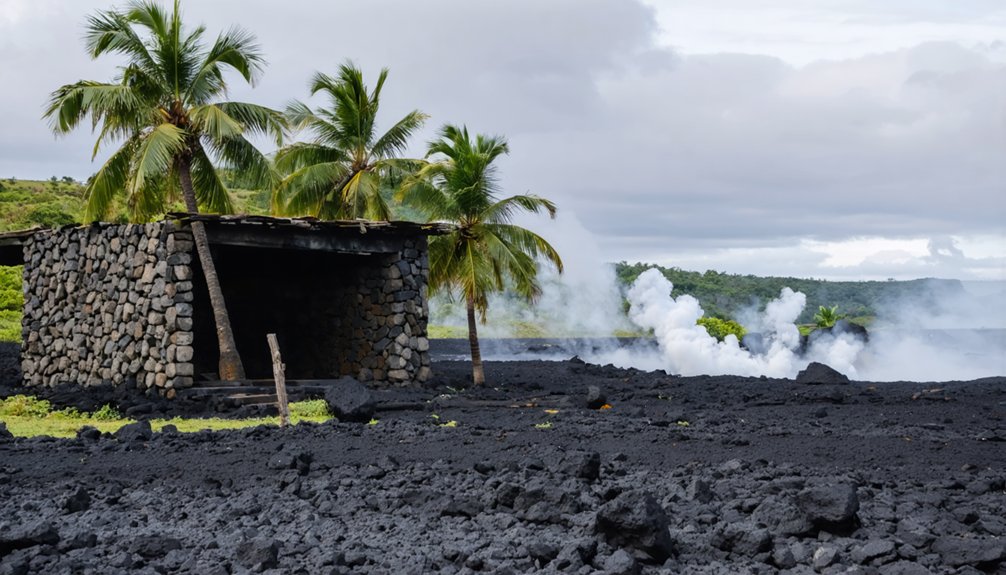
Modern-day Kalapana stands as a reflection of nature’s raw power and human resilience, where molten rock forever changed a thriving Hawaiian coastal village in 1990.
Through cultural storytelling and community resilience, you’ll discover how this remarkable place continues to capture hearts and inspire visitors.
- A handful of determined residents live off-grid, maintaining their ancestral connections despite the harsh volcanic landscape.
- The new black sand beach, formed from cooling lava, draws visitors across surreal volcanic plains.
- Local gatherings at the night market keep the spirit of community alive.
- Ancient coconut palm imprints in hardened lava tell stories of the village that once was.
- A makeshift tourism economy helps preserve Kalapana’s legacy while supporting its remaining residents.
Frequently Asked Questions
Are There Any Indigenous Plants Growing on the New Lava Fields?
You’ll find ‘A’ali’i, one of Hawai’i’s resilient native species, leading the ecological recovery on fresh lava flows, gradually preparing the way for other indigenous plants to establish their presence.
What Happened to the Marine Life After the Lava Reached the Ocean?
You’ll find the lava’s immediate impact devastated local marine ecosystems, boiling fish and destroying coral reefs. Yet, ironically, the nutrient-rich waters later attracted new life through enhanced phytoplankton growth.
Do Any Original Kalapana Families Still Maintain Traditional Fishing Practices Today?
You’ll find original Kalapana families still practicing traditional fishing techniques along the coastline today, though in smaller numbers. They’ve adapted their family traditions while preserving ancestral methods of harvesting.
How Long Does It Take for Lava Rock to Become Fertile Soil?
You’ll see soil formation begin within months, but it takes 10,000-100,000 years for volcanic regeneration to create truly fertile soil that’s rich enough to sustain abundant life and traditional farming practices.
What Traditional Hawaiian Ceremonies Are Still Performed in Modern-Day Kalapana?
Like a phoenix rising, you’ll find Hula performances honor ancestral connections in modern Kalapana, though they’re less frequent now. Contemporary Lūʻau gatherings blend tradition with community celebration when families reunite.
References
- https://www.to-hawaii.com/big-island/cities/kalapana.php
- https://www.civilbeat.org/2018/07/big-island-last-time-hawaii-had-lava-refugees-it-built-a-ghost-town/
- https://www.ghosttowns.com/states/hi/kalapana.html
- https://guinnessworldrecords.de/world-records/775512-largest-medical-ghost-town
- https://big-island-blog.com/towns-cities-on-the-big-island-of-hawaii/kalapana-a-town-forged-by-lava-flows/
- https://en.wikipedia.org/wiki/Kalapana
- https://kids.kiddle.co/List_of_ghost_towns_in_Hawaii
- https://volcano.si.edu/volcano.cfm?vn=332010
- https://www.hawaii-guide.com/big-island/big-island-hawaii-eruption-history
- https://en.wikipedia.org/wiki/Kīlauea
